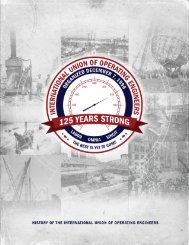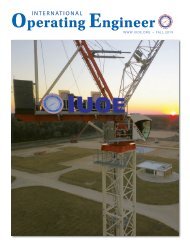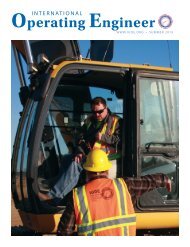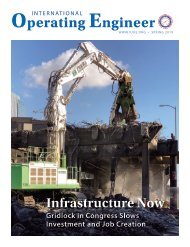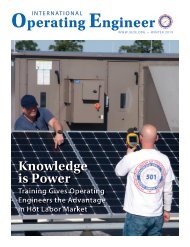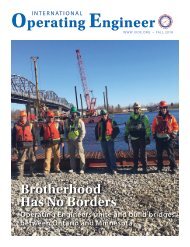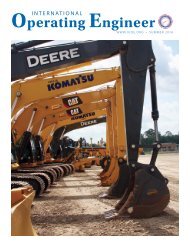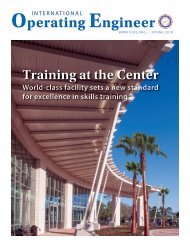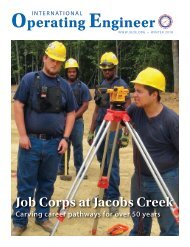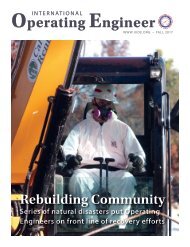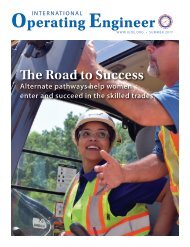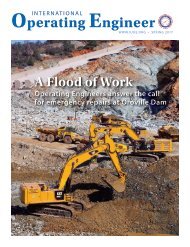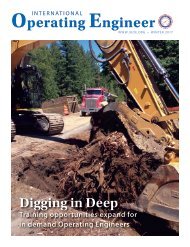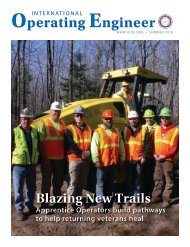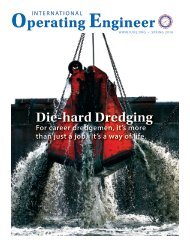International Operating Engineer - Summer 2015
The quarterly magazine of the International Union of Operating Engineers.
The quarterly magazine of the International Union of Operating Engineers.
- No tags were found...
Create successful ePaper yourself
Turn your PDF publications into a flip-book with our unique Google optimized e-Paper software.
Safety & Health<br />
Jobsite Pioneer Speaks Out for Worker Health<br />
Local 470 member tells how she went from operating cranes to saving lives<br />
AT ONE TIME she was in beauty school. A handful of years<br />
later, she could operate every single crane at the Department<br />
Of Energy’s Savannah River Site. And then, years after that,<br />
she started helping her former coworkers receive medical<br />
screenings for health problems they may have developed<br />
from hazards they were exposed to on the site.<br />
Talking to Glenda Jernigan is like hearing firsthand the<br />
history of labor in the late 20th century, both its successes and<br />
shortcomings. When she started at the Savannah River Site<br />
in 1983, her employers, MK Ferguson and later Bechtel, had<br />
never employed a woman as a crane operator. But operating<br />
cranes is exactly what Glenda had been trained to do from<br />
previous work with the IUOE. After passing a rigorous safety<br />
test, she became the first female crane operator employed by<br />
either of those contractors on the site.<br />
At a site like Savannah River, being able to operate a crane<br />
meant that Glenda was needed all over. She was an A-Class<br />
crane operator and could operate any crane on-site, including<br />
the Manitowoc-4100 which had a 250 foot boom and a 30 foot<br />
jib. She performed dual-lifts with other operators, and even<br />
used cameras to remotely operate cranes in waste transfer<br />
stations that were so radioactive that nobody was allowed<br />
inside. “I did some of everything,” she remembers. “I worked<br />
with every craft out there- the painters, the electricians, the<br />
boilermakers, the pipefitters, the ironworkers, the laborers.<br />
Everybody.”<br />
“And I had to dress out, go into radioactive areas. 221-H<br />
was the worst,” she pauses. “A lot of contamination in that<br />
area.”<br />
Of course, Glenda wasn’t the only worker who was exposed<br />
to radiation and other hazards while working construction<br />
at a DOE site. Thousands of workers, at Savannah River<br />
and at DOE sites across the country, have come face to face<br />
with materials and radiation that can have very serious<br />
health effects several years after exposure. “Trucks carrying<br />
radioactive waste would come out of the H-area Tank Farm,<br />
they’d leak and then safety crews would have to tear out<br />
the pavement. They’d tear up everything. And they’d even<br />
have to take the tires and wheels and different things off of<br />
peoples’ cars if they drove on contaminated ground,” she<br />
says. “I mean, you can see it going on around you and you<br />
know it’s not good.”<br />
Now, we know all too well what kinds of exposures Glenda<br />
and her coworkers could have encountered. Benzene.<br />
Radiation. Asbestos. Lead. The list goes on.<br />
Even today, Glenda is still piecing together how her body<br />
may be reacting to all the hazards she worked around. “It’s<br />
hard to put your finger on it to say this caused this, this<br />
caused that,” she sighs. “But I’m sure that some of the things<br />
I was exposed to have affected my lungs. My doctor told me I<br />
have asthma, and I never had asthma growing up as a child.<br />
This has only been in the last few years… and I have to take<br />
medication for it every day.”<br />
All this led Glenda to the Building Trades National<br />
Medical Screening Program (BTMed). BTMed, coordinated<br />
through CPWR – The Center for Construction Research and<br />
Training, offers free work history interviews and medical<br />
screenings to former construction workers at DOE sites. For<br />
several years, Glenda and her husband Charles (IBEW 1579)<br />
worked together as a team out of BTMed’s Savannah River<br />
outreach office, helping to inform workers about the benefits<br />
of BTMed. If BTMed can catch a serious illness early enough,<br />
it may prevent an early death.<br />
“We both talked about it, and we decided that it was a very<br />
good program, and we liked the idea of helping the workers<br />
at SRS and the other DOE sites because we knew what they<br />
were going through,” Glenda recalls. “Most people thought<br />
that there’s nothing out there to hurt workers, these workers<br />
are getting sick and things are happening to them for other<br />
reasons, it’s not what they’re getting exposed to on the job.<br />
And Charles and I both knew that that wasn’t true.”<br />
In ten years working for BTMed Glenda has interviewed<br />
hundreds of former SRS workers and heard their stories.<br />
“This one guy that I interviewed in our office…told me he<br />
actually put on diving gear and went down in a nuclear<br />
reactor pool because they had a leak in there, a crack in the<br />
reactor. And they were going to try to patch the crack. Now<br />
can you imagine that? And somebody letting him go do that?<br />
He ended up with thyroid cancer, I don’t know if he’s still<br />
alive or not.”<br />
Glenda has since retired from her position with BTMed,<br />
but her husband still works there, signing up as many former<br />
DOE construction workers as he can to get their health<br />
checked out. Workers are eligible for free checkups every<br />
three years, in order to catch an illness that might not show<br />
symptoms on the first exam. If you or someone you know<br />
worked construction at Savannah River or another DOE<br />
site across the country, visit www.btmed.org or call 1-800-<br />
866-9663 for more information. “[Those are] very dangerous<br />
place[s] to work,” Glenda warns. “And if you don’t know what<br />
you’re getting yourself into, you better be careful.”<br />
[left] Glenda Jernigan, one of the first female crane operators at<br />
the Savannah River DOE Site, sitting at the controls of her crane.<br />
[below] Map detailing DOE sites where former workers are eligible<br />
for free medical screenings through the BTMed program.<br />
[article] Building Trades National Medical Screening Program<br />
8<br />
INTERNATIONAL OPERATING ENGINEER<br />
SUMMER <strong>2015</strong> 9



